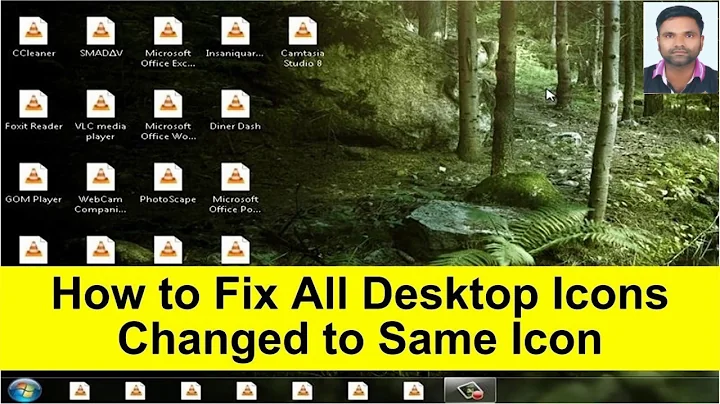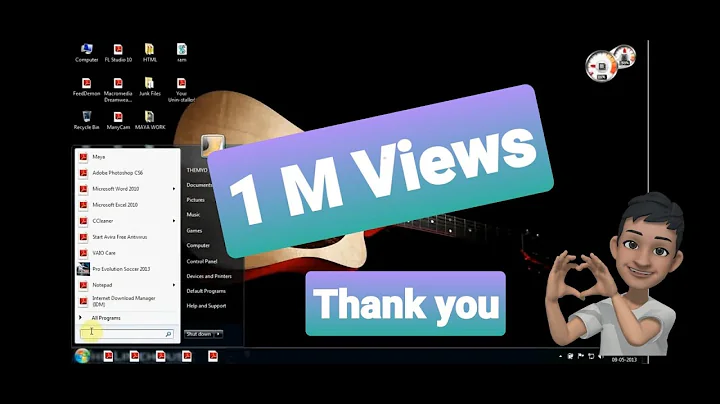How do I "persuade" programs open an actual .lnk file in Windows 7?
Solution 1
Opening shortcuts
In order to edit a shortcut you obviously need to open it first, and that proves to be tricky. In some cases you can force programs into loading shortcut files by using a command-line argument:
"X:\Path\to\program.exe" "X:\my shortcut.lnk"
Whether the link target or the actual shortcut file is loaded depends on the program, though. Here's a list (in no particular order) of some free hex editors which supports them out of the box:
-
Open dialog Yes
Drag-and-drop No -
XVI32, Free Hex Editor Neo, Tiny Hexer, wxHexEditor, Hex-Editor MX, Frhed
Open dialog No
Drag-and-drop Yes
Workaround
In case you're unable to load the content of a shortcut file, you can open a command prompt and rename the .lnk file to a different, non-existent extension such as .lne:
cd /d "X:\Folder\containing\shortcuts"
ren "my shortcut.lnk" "my shortcut.lne"
If you have multiple files you can also rename all of them at once:
ren *.lnk *.lne
You will be then able to treat those shortcuts just like regular files. When you're done, make sure to rename them back to restore their usual functionality.
Additional information
A shortcut, or shell link, contains metadata information used to access a specific link target. It's parsed and interpreted by the Windows shell. From the official documentation:
The shell link structure stores various information that is useful to end users, including:
A keyboard shortcut that can be used to launch an application.
A descriptive comment.
Settings that control application behavior.
Optional data stored in extra data sections.
Source: [MS-SHLLINK]: Shell Link (.LNK) Binary File Format - Overview
Shortcuts are stored as binary files, and can't be edited using a standard text editor. A typical .lnk file looks something like this internally:
00000000 4C 00 00 00 01 14 02 00 00 00 00 00 C0 00 00 00 L...........À...
00000010 00 00 00 46 DC 03 00 02 20 00 00 00 C6 EF 52 BE ...FÜ... ...ÆïR¾
00000020 10 04 CA 01 C6 EF 52 BE 10 04 CA 01 60 45 8A 67 ..Ê.ÆïR¾..Ê.`EŠg
00000030 20 04 CA 01 00 9A 04 00 00 00 00 00 01 00 00 00 .Ê..š..........
The first twenty bytes are always the following ones:
4C 00 00 00 01 14 02 00 00 00 00 00 C0 00 00 00 00 00 00 46
Further reading
Solution 2
I've tried this and it works for me on Windows 8.1:
Opening LNK files in Notepad:
- Just drag and drop them into the Notepad window. If you open them from the
Opendialog, Notepad will open theEXEfile pointed to by theLNKfile.
Opening LNK files in HxD hex editor:
- Open them as you would any file using the Open dialog (
File→Open)
Opening LNK files using the command prompt:
- Navigate to the folder containing the
LNKfiles and type the command:TYPE SHORTCUTNAME.LNK
Opening LNK files in just about any program:
- Start the command prompt, navigate to the folder where the program is located, use the command:
PROGRAM_NAME.EXE "path to LNK file"
Solution 3
The whole point of a .lnk file is for Windows to treat it as a link to another file so it should be hard to edit!
Perhaps it would help if you described WHY you want to edit it. You can change the settings of a .lnk file by right-clicking and choosing Properties.
If you really want to edit it, you need a special tool. There are a few of these including:
NB: I've not tried any of these, just Googled them.
UPDATE:
Don't know why I didn't think of this before but you can edit the properties via PowerShell. From this previous answer on Stack Overflow:
Copy-Item $sourcepath $destination ## Get the lnk we want to use as a template
$shell = New-Object -COM WScript.Shell
$shortcut = $shell.CreateShortcut($destination) ## Open the lnk
$shortcut.TargetPath = "C:\path\to\new\exe.exe" ## Make changes
$shortcut.Description = "Our new link" ## This is the "Comment" field
$shortcut.Save() ## Save
As this uses the Shell COM object, you could also do this with WSH or even VBA in Office!
Solution 4
.LNK files are interpreted by the shell. If you open up a command prompt and invoke your editing tool (let's just say Notepad for example) using the .LNK file as an argument, that should bypass the shell and open up the contents of the .LNK file itself.
notepad.exe shortcut.lnk
Solution 5
If you use CMD to run a program with the link file as a parameter, that parameter is passed verbatim to the program. It is up to the program to decide how to handle the link.
I have tested this with FRHED, the freeware (and portable) hex editor: when you run it from the command line, passing a link as parameter, it prompts you whether you want to open the file linked to (Yes), the link itself (No), or Cancel.
Oddly, if you use Open within the FRHED File menu, it opens the target file without asking.
On XP I have FRHED in my SendTo context menu, and that works the same way as CMD. I imagine Win7 is similar (I use a Win7 system for a dedicated application, and I will do simple tests on it, as above, but I don't mess with its configuration).
Related videos on Youtube
Jez
Long-time coder, with some interest in French and Philosophy. I sometimes hang out in the English Language & Usage chatroom. Check out my Firefox addons! :-)
Updated on September 18, 2022Comments
-
Jez over 1 year
A
.lnkfile in Windows is an actual file intended to be a shortcut to another file. However, I really do want to view the contents on the.lnkfile itself. I'm finding it literally impossible to do so; no matter what I try, my applications are opening the contents of the file it points to (drag/drop into text or hex editor, file | open from text or hex editor, etc.)Is there some way I can tell a program to actually open the .lnk file instead of the file it points to?
-
Jon almost 10 yearsYou can always rename it to .txt or something. Usually this doesn't cause it to lose any data.
-
 287352 almost 10 years@Chipperyman Except that that doesn't work. You cannot easily rename
287352 almost 10 years@Chipperyman Except that that doesn't work. You cannot easily rename.lnkfiles with a new extension.
-
-
Jez almost 10 yearsI want to edit its contents, preferably in a hex editor, because I think it might be corrupt and I don't trust Explorer to properly tell me its contents.
-
Julian Knight almost 10 yearsI suppose that recreating it is out then? If so, try one of the editors though I'm not sure what would have corrupted it.
-
Jez almost 10 yearsNope, that doesn't work. It opens up the file the
.lnkpoints to. -
 Vinayak almost 10 yearsThat is incorrect. I've tried this answer and it does work.
Vinayak almost 10 yearsThat is incorrect. I've tried this answer and it does work. -
 Vinayak almost 10 yearsThat isn't Windows prompting you. That's Frhed asking you what to do
Vinayak almost 10 yearsThat isn't Windows prompting you. That's Frhed asking you what to do -
 AFH almost 10 yearsQuite right: silly of me - I'll change my answer.
AFH almost 10 yearsQuite right: silly of me - I'll change my answer. -
Jon almost 10 years@Vinayak That's a pretty bold statement. It may work for you in the situation you are using it in but it might not work for Jez.
-
Julian Knight almost 10 yearsThe price of progress! Not much point in having a mechanism to define links that most apps then ignore. I don't know of many reasons to need to edit .lnk's directly.
-
Jez almost 10 yearsUsing HxD to open it via
File | Openactually seems to have opened the.lnkfile. Thanks. -
Chris H almost 10 years@JulianKnight I had a use once for generating them programmatically for placement in a folder that acted as an index. I had to assume no rights to install software, but we were already using VBA. Modifying a template .lnk proved easier than generating one from scratch.
-
Julian Knight almost 10 yearsInteresting use case. That hadn't occurred to me, I must admit.
-
 Scott - Слава Україні almost 10 yearsI find putting Notepad into my
Scott - Слава Україні almost 10 yearsI find putting Notepad into mySendTomenu to be very useful, letting me open any file (including shortcuts) in Notepad. -
 AFH almost 10 yearsFinal (?) observation: any DOS-based view or edit program will always open the link, never the target, since the DOS file open function does not know anything about links, so makes no special handling for them, unlike the Windows file open.
AFH almost 10 yearsFinal (?) observation: any DOS-based view or edit program will always open the link, never the target, since the DOS file open function does not know anything about links, so makes no special handling for them, unlike the Windows file open. -
and31415 almost 10 years@Jez I've updated my post to include some extra information. Let me know if you have any further questions.
![[How To] Get Back Your folders which turned to .lnk files](https://i.ytimg.com/vi/gB69a2N3-mw/hq720.jpg?sqp=-oaymwEcCNAFEJQDSFXyq4qpAw4IARUAAIhCGAFwAcABBg==&rs=AOn4CLBOGIxwZhNpReXcX30OPy2hqy-77Q)



